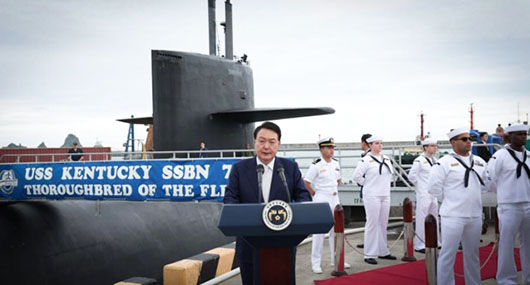FPI / July 26, 2023
By Richard Fisher
A week of nuclear threat diplomacy in Asia underscores the essential importance of nuclear weapons to sustaining stability in that region, but also underscores that the United States requires a far larger regional nuclear arsenal to fulfill its extended deterrence commitments.

On July 13 North Korea conducted a second successful test of its new Hwasong-18 mobile and solid fuel intercontinental ballistic missile (ICBM), that is about the same size and very likely mirrors the design of China’s 12,000-kilometer range Dong Feng DF-41 ICBM.
This means that impoverished and oppressed North Korea has the same nuclear weapons as its Communist dictatorship ally and is able to blackmail Washington from defending its allies in Asia.
But in this year, North Korea has revealed that it has seven ballistic and cruise missiles and one long range unmanned underwater vehicle (UUV) armed with a new tactical nuclear weapon, so Pyongyang can now wage tactical nuclear war at shorter ranges, medium ranges and general nuclear war at intermediate and intercontinental ranges.
The fact that this ICBM’s transporter-erector-launcher (TEL) is designed and likely built by the China Aerospace Science and Industry Corporation (CASIC) indicates a high likelihood that Chinese companies also helped design the Hwasong-18 missile, so North Korea could become a proxy Chinese nuclear threat to South Korea, Japan and the United States.
On July 21, speaking at a conference of the liberal Aspen Institute, U.S. Secretary of State Antony Blinken warned China:
“We believe that you have unique influence and we hope that you’ll use it to get better cooperation from North Korea…But if you can’t or if you won’t, then we’re going to have to continue to take steps that aren’t directed at China but that China probably won’t like because it goes to strengthening and shoring up not only our own defenses but also those of South Korea and Japan and a deepening of the work that all three of us are doing together.”
Blinken was insufficient on two levels. First, he continued the U.S. trend of failing to accuse China of being intimately involved in North Korea’s nuclear weapon and missile programs, which is something far greater than having mere “unique influence.”
This U.S. refusal to call out China started in 2011 when the Obama Administration first learned from intelligence satellites that CASIC has transferred its first 16-wheel TELs to North Korea.
In part due to this failure, North Korea’s TEL has since undergone three more generations of design changes, to include a version with 22 wheels, now the world’s largest.
Full Report . . . . Current Edition . . . . Subscription Information
Free Press International
